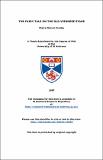Files in this item
The fairy tale on the old Viennese stage
Item metadata
| dc.contributor.author | Crosby, Claire Darryl | |
| dc.coverage.spatial | 243 p., 8 p. of plates | en_US |
| dc.date.accessioned | 2017-06-08T12:55:00Z | |
| dc.date.available | 2017-06-08T12:55:00Z | |
| dc.date.issued | 1987 | |
| dc.identifier | uk.bl.ethos.304024 | |
| dc.identifier.uri | https://hdl.handle.net/10023/10950 | |
| dc.description.abstract | The thesis deals with fairy tales on the Viennese stage and their narrative sources from the beginning of the eighteenth century to 1848. In the introductory chapter a statistical analysis of fairy tales illustrates that while the Viennese were greatly under the influence of fairy tales published in other German-speaking lands, the fairy tale on the Viennese stage did not follow the trends of the fairy tale in German literature. The first of the three main chapters discusses the dramatizations of the oriental fairy tales shown in Vienna. Raimund's Der Diamant des Geisterkönigs is one example. Wieland' s fairy tales provided the Viennese dramatists with a lot of source material, not only of oriental origin, but even of Italian origin too. The second main chapter analyses the sources of Vulpius’s Die Saal-Nixe and looks at the different works inspired by this typical Sage der Vorzeit, including Hensler's Das Donauweibchen and Grillparzer's Melusine. The theme of the white deer links these works with the oriental tale about Cheheristany and La donna serpente, an Italian play by Gozzi which provided Raimund with material for Der Verschwender. The third main chapter studies the close interaction of the French and German folk tales in literature and on the Viennesestage. The two examples chosen are the stories about Rübezahl and Fortunatus. Special attention is paid to Musäus who wrote stories about both these folk-tale figures and whose collection of folk tales was a popular source of dramatization. The failure of the Grimm Brothers to inspire Viennese dramatists is contrasted with the success of popular authors, such as Langbein. The conclusion summarizes first the sources of Viennese fairy-tale dramas and secondly the similarities and differences between the fairy tale on the Viennese stage and in German literature. And finally the demise of the fairy tale is examined. | en_US |
| dc.language.iso | en | en_US |
| dc.publisher | University of St Andrews | |
| dc.subject.lcc | PT1291.F2V5C8 | |
| dc.subject.lcsh | Fairy tales in literature | en |
| dc.subject.lcsh | Fairy tales--Adaptations--History and criticism | en |
| dc.subject.lcsh | Theater--Austria--Vienna--History--18th century | en |
| dc.subject.lcsh | Theater--Austria--Vienna--History--19th century | en |
| dc.title | The fairy tale on the old Viennese stage | en_US |
| dc.type | Thesis | en_US |
| dc.type.qualificationlevel | Doctoral | en_US |
| dc.type.qualificationname | PhD Doctor of Philosophy | en_US |
| dc.publisher.institution | The University of St Andrews | en_US |
This item appears in the following Collection(s)
Items in the St Andrews Research Repository are protected by copyright, with all rights reserved, unless otherwise indicated.

